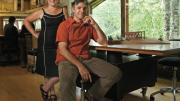In “The Three Little Pigs,” the big, bad wolf huffs and puffs and easily blows down the first piglet’s straw house. But with rising energy costs playing the wolf at the door, don’t dismiss straw houses too quickly. In southern Vermont, Dale and Michele Doucette and their two sons enjoy a large, comfortable home made of straw bales stacked to surround a post-and-beam frame like a blanket.

Photograph by Joseph Cincotta
Exterior of the Cincotta-designed house built with straw bales sheathed in plaster.
“Straw walls typically have an R factor ranging from 30 to 50—and if you factor in ‘air tightness,’ they can save energy on the order of an R-70 fiberglass wall,” says architect Joseph Cincotta, M.Arch. ’88, who designed the Vermont straw-bale house and even helped sheathe the straw in two layers of plaster. “The typical wooden-stud wall has an R factor of about 12.” (R factor is an index of an insulating material’s resistance to heat transfer.) The energy efficiency of the Doucettes’ straw-bale house has enabled them to leave the power grid behind; they meet their needs with solar and wind power, backed up by propane tanks.

Photograph by Joseph Cincotta
An entryway in the straw-bale house. (Below, the same arched doorway during construction, with straw exposed.)

Photograph by Joseph Cincotta

Photograph by Julie Lineberger
Part of the second-floor kitchen/dining area, which opens onto a deck.
Straw has other advantages: it contains a natural fire retardant, for example, making it less flammable than wood. “It’s really hard to light a bale of straw,” Cincotta explains. Yet straw, like wood, is subject to damage by moisture—rot. So Cincotta took pains to keep rain water off the walls, widening the typical 12- to 18-inch roof overhang to 36 inches. “Sun and rain wear buildings down,” he says, “so good overhang is always good practice.” Nor did they put straw directly on the concrete foundations, he says. “The first 16 inches of wall are completely waterproof—concrete and foam—raindrops splash up well below the first bale of straw.” Finally, they took care to ensure that window sills and door openings would not trap water, and that any water that did somehow enter the walls would not remain there, using lime plaster—an old type used in the 1800s—both inside and outside the stacks of straw. “Lime plaster has more clay in it than cement plaster, so it is more porous,” Cincotta explains. “Moisture travels to dryness like heat to cold, so plaster that breathes allows wet straw to dry out.”
Furthermore, the fact that straw bales aren’t perfect cubes influenced the design. “I was inspired by the straw to try things I wouldn’t do in a wood home,” Cincotta says. The front door, for example, is arched. Cutting wooden arches, forming them, and bending sheetrock are expensive and time-consuming tasks, but arches are far easier to build with straw bales, whose shape is flexible, not rigid. And arches “tend to be a welcoming gesture,” Cincotta says. Influenced by the softer curves of straw bales, he also used curved lines on an outdoor deck and a soapstone kitchen countertop. Even the home’s plastered walls are not perfectly even and flat. “We embraced the handmade feel of that,” says the architect. “Those walls have character, and give a sense of soul to the place.”
“We are the kind of architectural firm that was doing these kinds of things long before sustainable architecture became fashionable,” says Julie Lineberger, M.Ed. ’82, Cincotta’s wife and business partner in LineSync Architecture (www.linesync.com) in Wilmington, Vermont. “It is just the way you live your life. We have ‘green’ in our DNA.” Cincotta adds, “To some firms, ‘green’ is an add-on, something you add to the process. I’m of the view that it is integral to the process: you need to make the right decisions from the very beginning.” Taking this approach to the Manhattan offices of R.G. Niederhoffer Capital Management (headed by Roy Niederhoffer ’87) meant building more than 250 monitors into curved walls, in an energy-efficient scheme that included power backup and enabled the firm to continue trading even during a New York brown-out.

Lisa and Gary Hall
Cincotta’s design for the Manhattan offices of R.G. Niederhoffer Capital Management, headed by Roy Niederhoffer ’87, called for embedding more than 250 monitors into curved walls.
Closer to home, at the 50,000-square-foot Sonnax Industries warehouse and headquarters in Bellows Falls, Vermont, Cincotta used foam-block construction. (“They’re like giant Legos,” he says.) The foam traps air and therefore insulates more than 20 times as well as a straight concrete wall. Sensors that monitor the internal and external environment of the Sonnax structure to adjust lighting and heating helped make it “the most energy efficient building in the state,” according to former Vermont governor Howard Dean.
Though most Harvard-trained architects join large firms in urban centers, Lineberger and Cincotta (the firm’s name echoes the first syllables of their surnames) settled in southern Vermont in 1988. Their small country town provides daily proof that the sustainable movement isn’t anything newfangled. “Active solar power means collecting energy from the sun to store and use, but ‘passive solar’ is simply taking advantage of sunlight coming through a window,” Cincotta observes. “Our grandfathers used passive solar. In an 1860s farmhouse, they’d put most of the windows on the southern face, to take in the sun. Environmental sustainability has roots in good old Yankee ingenuity.” Lineberger adds, “They were heating with wood, and it was precious. Once there was cheap oil, we got careless. The ‘new’ sustainability is really hearkening back to an earlier time, when the alternative was freezing in the cold.”
In LineSync’s philosophy, pragmatic considerations like sustainability trump architectural fashion. Cincotta’s father was a craftsman who had a small construction firm in Queens, New York; in his dad’s shop, the future architect learned about construction at its most practical level. He is no worshipper of architectural “styles.”
“When I was at the GSD [Harvard’s Graduate School of Design], postmodernism was the rage,” Cincotta recalls. “My sense was that it was a style that was going to come and go as quickly as it did.
“Everyone loves beautiful bridges,” he explains. “Bridges do what they do with a minimal amount of materials, and without froufrou. There’s a lesson there for those who get confused by styles. Architecture shouldn’t be in the fashion business—it’s way too expensive! If you put up a building and it goes out of fashion, 20 years from now it looks like a bad joke.”
At Harvard, such views got Cincotta into academic trouble: “Style is subjective, and I resented being taught style as if it were established knowledge.” His vocal rebelliousness caused the GSD to ask him to leave after two years, even as his work hung on the honors wall. Soon, Cincotta got a job as a site engineer overseeing construction of a shopping mall in the sultanate of Oman. Applying what he learned from indigenous desert architecture, he eventually designed the headquarters for Al Turki Enterprises, the construction firm that built the U.S. embassy there. The commercial/residential structure, now designated a national landmark in Oman, was completed after five years in 1986, with Cincotta closely involved in all stages of the construction. When he applied to Harvard for re-admission, the committee doubtfully considering his application wondered what Cincotta had actually done on the spectacular building pictured before them. The answer, as Lineberger says, was “Everything.”
Cincotta now works the faculty side of the street himself, teaching courses on “Building, Energy, and Sustainable Design” and “History and Theory of Modern Architecture” at Keene State College in New Hampshire. LineSync Architecture’s clients range from a sports-medicine center in Vermont to a retail chain in Amsterdam. Economics and politics have finally joined environmental concerns to support the firm’s “green” philosophy, and aesthetics is also part of the deal. “What I love about the sustainability issue,” Cincotta says, “is that beautiful forms can come out of a consideration of sustainable materials and processes.”









